The Kids Musical Instrument Market is estimated to be valued at USD 11.5 Billion in 2025 and is projected to reach USD 16.0 Billion by 2035, registering a compound annual growth rate (CAGR) of 3.4% over the forecast period.
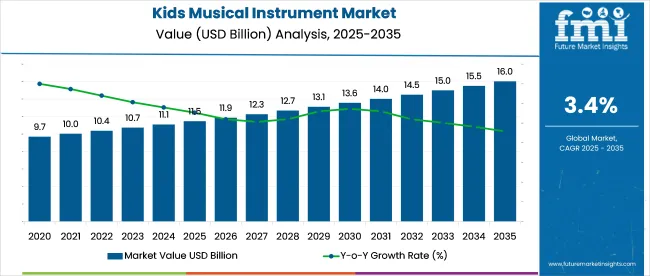
The kids musical instrument market is witnessing accelerated growth driven by the rising emphasis on early childhood development, creativity-focused learning environments, and the integration of music into cognitive development curricula. Parents and educators are increasingly recognizing the role of music in enhancing motor skills, emotional intelligence and auditory development in children. This shift has resulted in heightened demand for safe durable, and age-appropriate musical instruments tailored to young users.
Manufacturers are responding by offering fully functional miniaturized instruments that replicate the form and function of professional-grade equipment, while maintaining ergonomic and safety standards for children. Furthermore, the inclusion of music education in early learning programs and the expansion of edutainment platforms are fueling demand across schools and households.
With the surge in gifting trends and growing penetration of music subscription and tutorial services, future growth is expected to be propelled by interactive, tech enabled instruments and collaborative brand partnerships with content creators and educators.
The market is segmented by Product Type, Application, and Distribution Channels and region. By Product Type, the market is divided into Mini Fully Functional Instrument, Toy (Not Fully Functional), and Other. In terms of Application, the market is classified into For Children and For Toddlers.
Based on Distribution Channels, the market is segmented into Wholesalers/ Distributors, Independent Musical Instrument Stores, Online Retailers, and Others. Regionally, the market is classified into North America, Latin America, Western Europe, Eastern Europe, Balkan & Baltic Countries, Russia & Belarus, Central Asia, East Asia, South Asia & Pacific, and the Middle East & Africa.
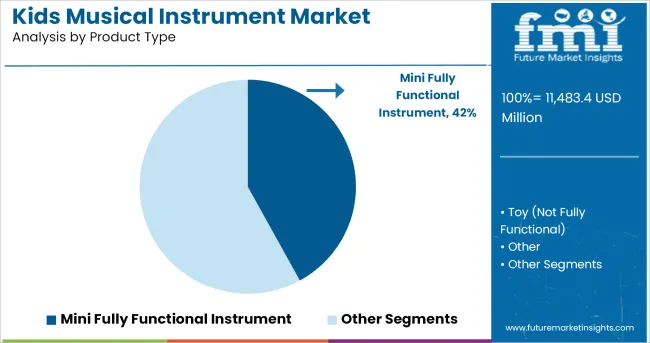
The mini fully functional instrument segment is anticipated to hold 42.0% of the total market revenue in 2025, positioning it as the leading product category. This leadership is underpinned by the increasing preference for instruments that simulate real playability while being scaled to child-friendly dimensions.
The ability of these products to offer an authentic musical experience enhancing skill development, engagement, and learning retention has significantly influenced their adoption by both parents and educational institutions. Enhanced materials, built-in safety features, and attention to acoustic quality have made these instruments suitable for formal instruction and home practice alike.
Additionally, the growing integration of Bluetooth connectivity, LED feedback systems, and digital tuning in these compact models has widened appeal among tech-savvy parents seeking interactive learning tools. These factors collectively reinforce the dominant position of mini fully functional instruments in the evolving kids musical instrument landscape.
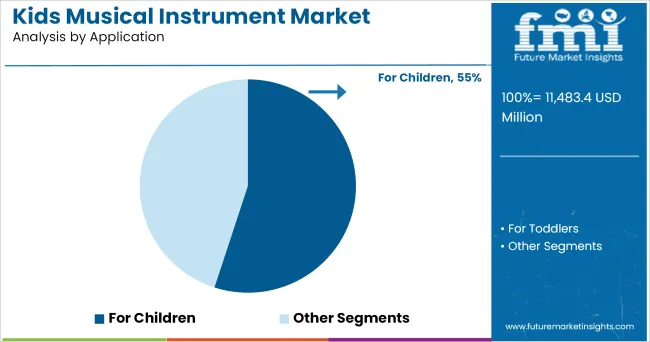
The for children segment is projected to represent 55.0% of market revenue in 2025 within the application category, confirming its position as the largest end-user segment. This dominance is attributed to growing parental and institutional focus on structured learning through play, where music is increasingly seen as a core developmental pillar.
Demand is particularly high in the 3-10 years age bracket, where cognitive, sensory, and emotional growth can be directly enhanced through musical engagement. The inclusion of music education in primary school curriculums and the rise of early learning centres have further reinforced adoption.
Child-safe construction standards, interactive features, and colourful designs have made products in this category appealing across both educational and recreational use cases. As parents continue to prioritize non-screen-based developmental tools, the for children segment is expected to maintain its leadership in market share.
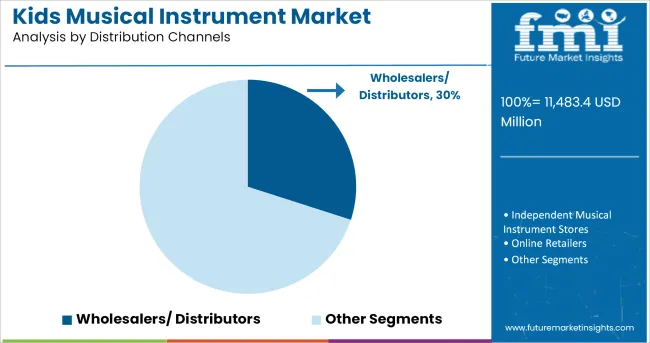
Wholesalers and distributors are projected to account for 30.0% of the total revenue in 2025 under the distribution channel segment, establishing them as a key driver of market accessibility. Their dominant role is driven by strong supply chain integration with schools, day-cares, music academies, and large-scale toy retailers.
Distributors facilitate bulk procurement, logistical efficiency, and category diversification, which are particularly valuable in educational and institutional sales. Additionally, wholesalers have played a central role in expanding product reach across Tier II and Tier III cities, where direct to consumer channels are still emerging.
The ability to provide value added services such as private labelling, bulk customization, and educational kits has strengthened their relevance across formal learning environments. With global brands increasingly relying on distributor networks for market penetration and inventory optimization, the wholesale channel is expected to remain pivotal to revenue generation and brand visibility across the kids musical instrument ecosystem.
According to the latest research by Future Market Insights, the kids musical instrument market is set to witness steady growth during 2025 to 2035, with a CAGR of around 3.4%. Demand for kids’ musical instruments is likely to grow with the rapid expansion and adoption of social media platforms among kids, which is going to attract them towards special acquired skills.
Additionally, the advancements in technology have led to the manufacturing of compact musical instruments without compromising the output of one hence, projected to boost sales.
One of the major factors that are driving the demand of kids musical instrument is the advancements in the technology that has led to the production of compact and small parts, providing variation in sizes without affecting the purpose, sound, and effect of the instrument. The list includes piano, keyboards, guitar, wind instruments available through both online and offline platforms.
Further, the growing impact and fame of western music among the millennials and kids and the growing popularity of electronic music in the developing regions will play a major key role in sustaining the demand for kids musical instruments.
Digitalization is one of the major factors driving the sales of kids musical instrument industry. With the presence of bloggers and influencers on various social media, applications tend to promote and attract kids towards new technologies and acquire skills, therefore, influencing the musical instrument industry.
Such platforms also allow kids to communicate with any professional artist in the musical industry irrespective of their location to conduct the one-to-one class and acquire the skill on the musical instrument. Further, the platforms also allow one to share their knowledge, experience with others and help reach solutions without harsh efforts.
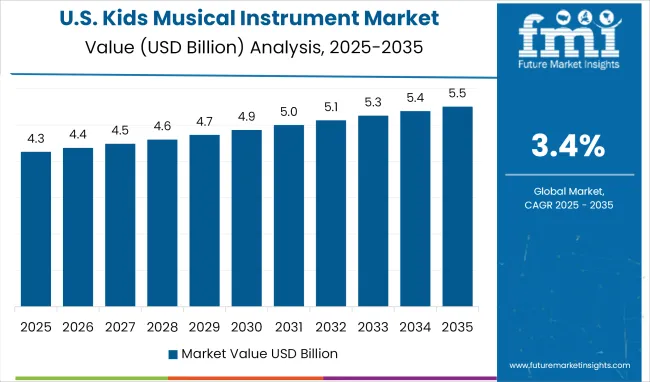
The countries of North America are the most lucrative market for the kids musical instrument industry. The USA kids musical instrument industry is set to grow in demand in the given forecast period due to the rising demands from the kids parents in the extra curriculum.
Further, the region consists of populace attracted and delighted with the advancement in technologies, therefore, the availability of compact and affordable kids musical instrument are likely to attract more customers, thus, boosting the sales in the forecast period 2025 to 2035.
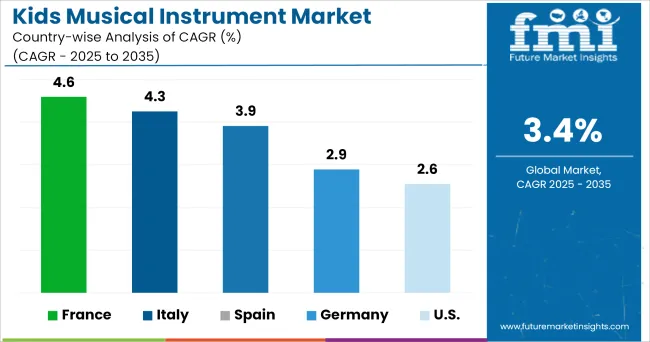
The region consists of various suppliers who are heavily dependent upon other countries who export raw material for the production of items, and the temporary pause on the exchange had influenced the manufacturers and suppliers, therefore, influencing the sales of kids musical instruments.
However, with the presence of a high regional economy, and certain regulations railed out by the governments, the countries have accepted and adapted to the current situation and are further, planning to initiate development and manufacturing of products within the countries to supply, reliable products and services to the customers. These factors are likely to boost the demand and sales of kids musical instruments.
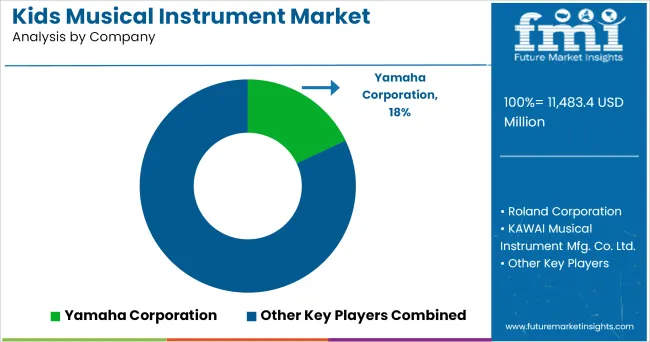
Some of the leading manufacturers and suppliers of kids musical instruments include
The report is a compilation of first-hand information, qualitative and quantitative assessment by industry analysts, inputs from industry experts and industry participants across the value chain.
The report provides in-depth analysis of parent market trends, macro-economic indicators and governing factors along with market attractiveness as per segments.
The report also maps the qualitative impact of various market factors on market segments and geographies.
The global kids musical instrument market is estimated to be valued at USD 11.5 Billion in 2025.
The market size for the kids musical instrument market is projected to reach USD 16.0 Billion by 2035.
The kids musical instrument market is expected to grow at a 3.4% CAGR between 2025 and 2035.
The key product types in kids musical instrument market are mini fully functional instrument, toy (not fully functional) and other.
In terms of application, for children segment to command 55.0% share in the kids musical instrument market in 2025.






Our Research Products

The "Full Research Suite" delivers actionable market intel, deep dives on markets or technologies, so clients act faster, cut risk, and unlock growth.

The Leaderboard benchmarks and ranks top vendors, classifying them as Established Leaders, Leading Challengers, or Disruptors & Challengers.

Locates where complements amplify value and substitutes erode it, forecasting net impact by horizon

We deliver granular, decision-grade intel: market sizing, 5-year forecasts, pricing, adoption, usage, revenue, and operational KPIs—plus competitor tracking, regulation, and value chains—across 60 countries broadly.

Spot the shifts before they hit your P&L. We track inflection points, adoption curves, pricing moves, and ecosystem plays to show where demand is heading, why it is changing, and what to do next across high-growth markets and disruptive tech

Real-time reads of user behavior. We track shifting priorities, perceptions of today’s and next-gen services, and provider experience, then pace how fast tech moves from trial to adoption, blending buyer, consumer, and channel inputs with social signals (#WhySwitch, #UX).

Partner with our analyst team to build a custom report designed around your business priorities. From analysing market trends to assessing competitors or crafting bespoke datasets, we tailor insights to your needs.
Supplier Intelligence
Discovery & Profiling
Capacity & Footprint
Performance & Risk
Compliance & Governance
Commercial Readiness
Who Supplies Whom
Scorecards & Shortlists
Playbooks & Docs
Category Intelligence
Definition & Scope
Demand & Use Cases
Cost Drivers
Market Structure
Supply Chain Map
Trade & Policy
Operating Norms
Deliverables
Buyer Intelligence
Account Basics
Spend & Scope
Procurement Model
Vendor Requirements
Terms & Policies
Entry Strategy
Pain Points & Triggers
Outputs
Pricing Analysis
Benchmarks
Trends
Should-Cost
Indexation
Landed Cost
Commercial Terms
Deliverables
Brand Analysis
Positioning & Value Prop
Share & Presence
Customer Evidence
Go-to-Market
Digital & Reputation
Compliance & Trust
KPIs & Gaps
Outputs
Full Research Suite comprises of:
Market outlook & trends analysis
Interviews & case studies
Strategic recommendations
Vendor profiles & capabilities analysis
5-year forecasts
8 regions and 60+ country-level data splits
Market segment data splits
12 months of continuous data updates
DELIVERED AS:
PDF EXCEL ONLINE
Kids Splint Market Size and Share Forecast Outlook 2025 to 2035
Kids Toys Market Size and Share Forecast Outlook 2025 to 2035
Kids Sports Equipment and Accessories Market Size and Share Forecast Outlook 2025 to 2035
Kids Shampoo Market Size and Share Forecast Outlook 2025 to 2035
Kids’ Brain Health Supplements Market Size and Share Forecast Outlook 2025 to 2035
Kids Sports Injury Treatment Market Size and Share Forecast Outlook 2025 to 2035
Kids Storage Furniture Market by Type, Material, End-Use, and Region - Growth, Trends, and Forecast through 2025 to 2035
Kids’ Food and Beverages Market Analysis by Product Type, Age Group, Category, Distribution Channel and Region through 2035
Kids Apparel Market Trends - Growth, Demand & Forecast 2025 to 2035
Kids Recreational Services Market by Activity Type, Service Type, and Region - Forecast to 2025 to 2035
Kids Watch Market
Kids’ Eyewear Market Report – Trends & Forecast 2024-2034
Air Caster Skids System Market Size and Share Forecast Outlook 2025 to 2035
Probiotic for Kids Market Analysis - Size, Share, and Forecast 2025 to 2035
Industrial RO Skids Market Analysis - Size, Share, and Forecast Outlook 2025 to 2035
Mesh Nebulizer for Kids Market Size and Share Forecast Outlook 2025 to 2035
Coolant Filtration Skids Market Analysis - Size, Share, and Forecast Outlook 2025 to 2035
Luxury Products For Kids Market - Trends, Growth & Forecast 2025 to 2035
Musical Instrument Market Analysis - Size, Share, and Forecast Outlook 2025 to 2035
Analyzing Musical Instrument Market Share & Industry Leaders

Thank you!
You will receive an email from our Business Development Manager. Please be sure to check your SPAM/JUNK folder too.
Chat With
MaRIA